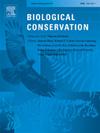Long-term trends in the extent of Pseudogymnoascus destructans infection in little brown myotis
IF 4.9
1区 环境科学与生态学
Q1 BIODIVERSITY CONSERVATION
引用次数: 0
Abstract
Infectious diseases pose a significant threat to wildlife, with invasive pathogens increasingly causing population declines or extinctions in naïve host species. Despite the risks, efforts to prevent or manage their emergence, spread, and impacts have been limited, and a better understanding of host-pathogen interactions is needed to inform wildlife management and policy. In particular, longitudinal studies, especially those incorporating data from the early stages of pathogen invasion, are critical for understanding disease dynamics but remain rare. The fungus Pseudogymnoascus destructans (Pd), which causes the deadly disease white-nose syndrome (WNS) in hibernating bats, is a prime example of a highly virulent invasive pathogen. Using 13 years of data from >750 bats, we examined long-term trends in Pd infection in Myotis lucifugus from the initial invasion to the widespread establishment of the pathogen in Pennsylvania. We also explored sex-based variation in infection, which may arise from differences in pathogen exposure or host susceptibility. We found an overall decline in infection extent over the years, more notably in females, which may be attributed to several possible mechanisms. Moreover, females' infection levels exceeded those of males in late hibernation, with the trend reversing by spring, suggesting more heavily infected females might be emerging earlier and/or dying at higher rates than other individuals. While the demographic consequences remain unclear, our findings reveal changing WNS disease dynamics, underscore the importance of longitudinal studies in understanding host persistence mechanisms, and highlight the value of early and continued monitoring to guide effective disease management, wildlife conservation, and policy.
求助全文
约1分钟内获得全文
求助全文
来源期刊

Biological Conservation
环境科学-环境科学
CiteScore
10.20
自引率
3.40%
发文量
295
审稿时长
61 days
期刊介绍:
Biological Conservation is an international leading journal in the discipline of conservation biology. The journal publishes articles spanning a diverse range of fields that contribute to the biological, sociological, and economic dimensions of conservation and natural resource management. The primary aim of Biological Conservation is the publication of high-quality papers that advance the science and practice of conservation, or which demonstrate the application of conservation principles for natural resource management and policy. Therefore it will be of interest to a broad international readership.
 求助内容:
求助内容: 应助结果提醒方式:
应助结果提醒方式:


